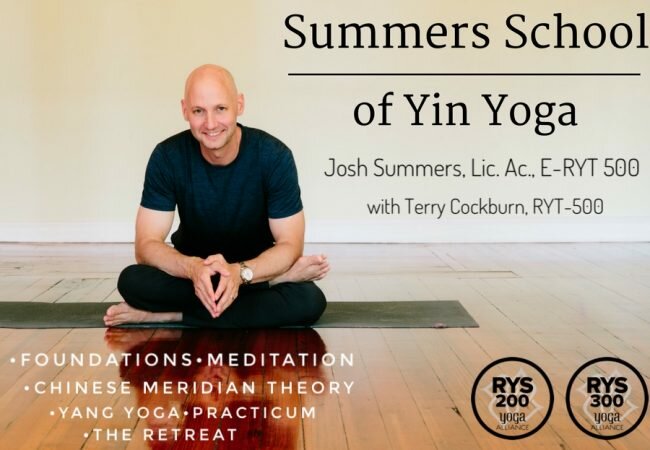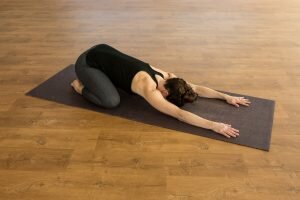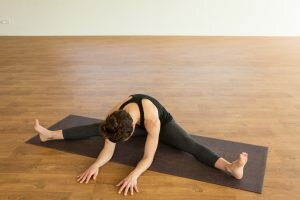While our tendency may be to hide under a blanket until spring arrives, our yin yoga practice can replenish and revitalize the body, and help to find harmony with this cold, dry season. According to Traditional Chinese Medicine (TCM), water is the primary element of winter, and this month’s sequence is designed to target the kidneys and urinary bladder by stimulating the meridians that run down the front and back of the spine, as well as down the back of the legs and up the inner thighs. Postures that encourage full circulation of the backline of the body especially the spine and the lower back around the kidneys, will help replenish our vital energy.
These poses can be practiced sequentially as outlined or can be “cherry-picked”, by selecting a few postures to practice each day.
How to Practice
There are four main principles of Yin Yoga. First, we come into a shape and go to the first point of resistance, and from that mild “edge” of sensation, observe what is being felt. The sensation should be no more than a mild, dull ache, and not gravitate toward anything sharp, stabbing or burning.
The second principle is to remain still. With the muscles relatively relaxed, the stress will transfer to the denser connective tissues. Keep in mind, you are not fixed in a single spot for the duration of the pose. Do be sure to change the angle of the pose to accommodate for any release, or to back away from a sensation that becomes too intense.
Third, yin postures are held for longer periods of time. Postures can be held anywhere from three to even 20 minutes, but start with a time frame that makes sense for you, honoring the foregoing tenets.
The Sequence
1)Butterfly. From a seated position, draw the soles of the feet together, allowing the knees to go wide. Let the feet be further away from the hips, and incline the body forward.
2)Sphinx. Place the elbows under the shoulders, keeping the legs relaxed. The Head may be kept in a neutral position, fall forward, or rest on a block.
3(a) Seal. Transitioning from Sphinx, fully extend the arms, moving the hands toward the body any amount that allows for an appropriate amount of sensation to the lumbar spine. Hands may turn in or out. Variation B shows the hands being brought closer to the body. This can increase spinal extension and could bring more sensation.
4) Tadpole. Fold the upper body over the thighs with the hips settled toward the heels. Extend the arms forward.
5) Caterpillar. Extend the legs and fold the upper body to any degree. Sit on a blanket if there’s a tendency to roll back on hips, and try supporting knees with a rolled up blanket if there’s too much resistance in the backs of the legs.
6) Snail. Lie on the back and swing the legs overhead. Feet may touch the ground or hover in the air. Hands can be placed on the lower back or clasped as shown. Avoid this pose if there are any issues with the cervical spine. Upon releasing, be sure to hug knees to the chest for a minute or two.
7(a) Frog. Take the knees wider than the hips and draw the hips forward of the heels to target the inner lines of the legs. Play with the angling of the feet (turned out or neutral), and rest on the forearms, or as shown in 7(b), bring the chest to the floor.
8) Dragonfly side body. Take the legs wide and let the right arm rest on the ground or elbow up on a prop, supporting the head, as shown, with the left arm draping overhead to invite sensation along the left side of the trunk. Repeat on the left side.
9) Dragonfly. After the lateral positions to the right and left, allow the upper body to fold forward, resting the palms, forearms, or torso on the floor. The sensation may be felt along the inner lines of the legs or along the backline of the body.
10) 1/2 Stirrup on Bolster. Place a bolster under the sacrum and draw the right leg in, holding the outside of the foot as shown, or catching hold of the knee. Allow the left leg to be fully relaxed. Repeat left side. (this can be an alternative to dragon pose, as it targets the groin of the leg drawn in, and can stimulate the hip flexor of the extended leg)
10 (1) Release. From Half Stirrup, release and extend one leg (as shown). This will create a spinal extension and a lengthening to the front line of the body. This can be done in conjunction with a 1/2 stirrup, or as a stand-alone pose.
11) Full Stirrup. Collect both feet or knees, drawing the thighs away from the midline. Allow the weight of the sacrum and downward movement of the thighs to offer gentle traction to the lumbar spine. Sensation in the inner thighs may be experienced as well.
12) Full Release. Extend both legs as shown. If this creates a sensation that’s beyond an appropriate edge, bend one leg and alternate.
13) Easy Twist on Bolster. From a lying position, draw your right leg across the body, allowing the lower leg to rest on a bolster. Hips will stack, and the upper body will draw toward the floor to create a gentle spinal twist. Rest the left hand on the abdomen and bring awareness to the breath. This pose is intended to be restorative and pacifying in nature. Let there be a restful quality to the body as you steady the mind with even, full abdominal breathing.
14) Pentacle. Lie on the back with the legs slightly wider than hips, and arms overhead, palms facing the ceiling.
Photos by Cindy Giovagnoli
Disclaimer: Not all yoga poses are suitable for all persons. Always consult your health care provider and obtain full medical clearance before practicing yoga or any other exercise program. The information provided in this blog is strictly for reference only and is not in any manner a substitute for the medical advice or direct guidance of a qualified yoga instructor.








